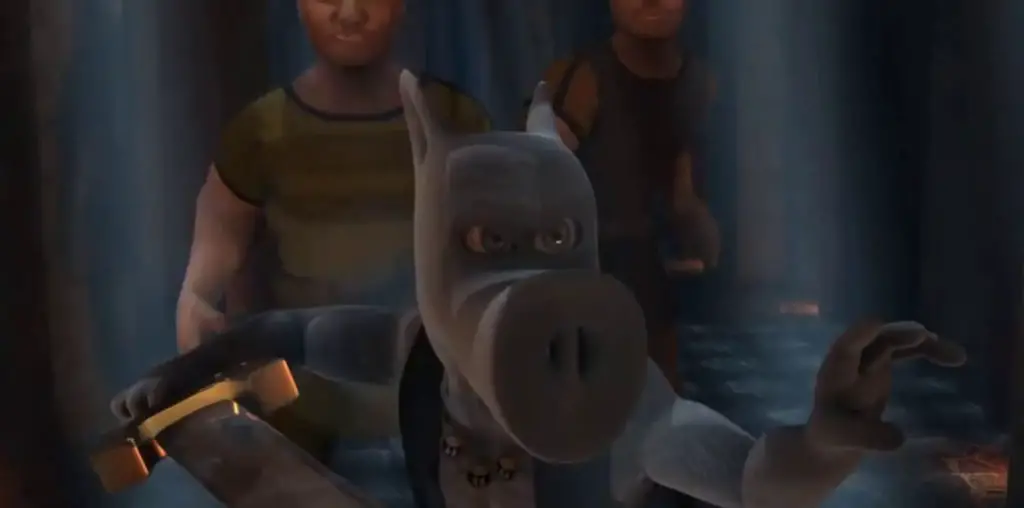
“The Indeserian Tablets” is a complex, mesmerizing and beautiful short by Peter Rose. It begins with a quote from a poem which laments a vanished culture: “…of the tessellated gazebos and keening skies, only flameflutter and windflap.” The quote is attributed to one “Rendaw Ipeck.” The film is in the form of an archeological treatise on a fictional vanished people, whom Rose imagines living in a remote past, with an advanced technology which is quite unlike our own. One section describes the Indeserian writing system: “Their scripture used a two-dimensional system of notation, that made great demands upon the skills of ambidextrous scribes.” This spoken text is accompanied by an image which seems to be of a bumpy rock, illuminated solely by two moving lasers, which indeed makes it look like an esoteric script written in two dimensions. (The accompanying sounds could be steel cutting through rocks.) All the film’s images are similarly made by illuminating familiar objects and scenes with moving, hand-held lights.
An isolated shaft of light, hitting blades of grass, looks something like a complicated green crystal, which the voice-over text suggests was used for transforming biological energy into mathematical theorems, used “to terrorize enemies and beckon kinsmen.” The sound, which might originally have simply been traffic, is transformed by reverb so that it sounds like a mighty factory, breathing in and out. Other sections examine esoteric religious cults of the Indesarians, art, gossip (which has its own, more flexible script), and astronomy.
Rose’s visual technique, of illuminating unlit scenes with lasers, turning objects such as water, grass, and rocks into magical, abstract compositions of space, color and light, creates a sense of human vision which is active and tactile. The eyes are not mere passive receptors of images. The lasers act almost like extensions of one’s hands, reaching out to caress the landscape, and to actively create the space. Because lasers impose narrow lines onto a three-dimensional space, they create linear forms which resemble writing. This gives the images a wonderful spatial ambiguity, where every line of light can be interpreted either as lines written on paper, or as a slice of a spacious scene, cutting up the everyday world and rendering it mysterious.
As the lasers touch the landscape, they are, in a sense, “writing” the scenery, creating constantly shifting tableaux through their tactile encounter with the visible. There is a subtle but profound connection, in this film, between the images, where lasers “write” on the space, making fantastically odd and gorgeous sculptural forms, and the accompanying faux archeological text, in which the author reaches into the collected literature of ancient civilizations, and uses these historical fragments to create his own invented culture, a culture with a barbarism and a sophistication which is strange and inspiring.
Reading the film this way helps to explain the feeling of awe created by a late section, in which we see laser lights caressing two open and turning hands, accompanied by the sound of bells. We learn that these hands were “the only licensed tokens of divinity. All other images were forbidden.” To hold the light in your empty hands, so that the Word and the Image are formed in the moment, completely fused, is indeed a divine image.
The intentional satire of Rose’s language, with its pretentious tone and made-up terminology, will, at times, be laugh-out-loud funny to anyone who has spent time in an academic environment. At the same time, his breathtakingly beautiful sound and image compositions will fill you with wonder. With “The Indeserian Tablets,” Peter Rose is digging deep into the origins of language, vision, and creativity, and using his archeological findings to create a film of wit, intelligence, and awe-inspiring beauty.

Watching this, I was reminded of E. Elias Merhige’s brilliant “Begotten,” which seemed like an impossibly ancient creation myth recorded on papyrus film stock and then stored away in a cave for many thousands of years before being discovered. THIS short film’s use of cryptic audio and visual information looks both alien and yet tantalizingly familiar. Pretty fascinating.